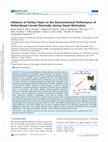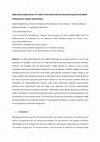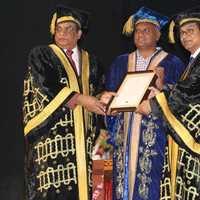Papers by Dimitrios Niakolas
Performance of a PEM water electrolysis cell of Irbased oxide electrodes containing Nb, Ta and Ru... more Performance of a PEM water electrolysis cell of Irbased oxide electrodes containing Nb, Ta and Ru for oxygen evolution reaction at 150°C
Electrochimica Acta, Jun 1, 2023
International Journal of Hydrogen Energy, Jun 1, 2023
ESA Special Publication, Aug 1, 2014

Advanced Energy Materials, 2013
Solid oxide fuel cells (SOFCs) have grown in recognition as a viable technology able to convert c... more Solid oxide fuel cells (SOFCs) have grown in recognition as a viable technology able to convert chemical energy directly into electricity, with higher efficiencies than conventional thermal engines. Direct feeding of the SOFCs anode with hydrocarbons from fossil or renewable sources, appears more attractive compared to the use of hydrogen as a fuel. The addition of mixed oxide‐ion/electron conductors, like gadolinium‐doped ceria (GDC), to commonly used nickel‐based anodes is a well–known strategy that significantly enhances the performance of the SOFCs. Here we provide in situ experimental evidence of the active surface oxidation state and composition of Ni/GDC anodes during methane electroxidation using realistic solid oxide electrode assemblies. Ambient pressure X‐ray photoelectron and near edge X‐ray absorption fine structure spectroscopies (APPES and NEXAFS respectively) combined with on line electrical and gas phase measurements, were used to directly associate the surface stat...
ECS transactions, May 19, 2023

ECS Transactions, 2021
In a time, where first solid oxide based systems enter demonstration and commercial markets, the ... more In a time, where first solid oxide based systems enter demonstration and commercial markets, the European NewSOC project focuses on next generations. It aims at significantly improving performance, durability, and cost competitiveness of solid oxide cells and stacks compared to state-of-the-art (SoA). In order to achieve these goals, NewSOC investigates twelve innovative concepts in the following areas: (i) structural optimization and innovative architectures based on SoA materials, (ii) alternative materials, which allow for overcoming inherent challenges of SoA, (iii) innovative manufacturing to reduce critical raw materials and reduction of environmental footprint at improved performance and lifetime. The NewSOC unifies competences of 16 strong research and industry players. First scientific highlights were achieved despite the challenging working conditions under the European wide Covid-19 restrictions in the first year of the project. The presentation will provide a selection o...
Journal of Power Sources, 2019
Determination of the electrochemical reaction processes by the use of ADIS. � Chemical-electroche... more Determination of the electrochemical reaction processes by the use of ADIS. � Chemical-electrochemical competing processes by means of Gerischer impedance response. � Autocatalytic effect of H 2 O on the promotion of H 2 electro-oxidation on Ni/ GDC anode. � The main promoting step is the reaction of H 2 O with O 2 to form OH ad on GDC.

ACS Applied Energy Materials, 2019
Due to their fuel flexibility and high efficiency, solid oxide cells are a promising technology f... more Due to their fuel flexibility and high efficiency, solid oxide cells are a promising technology for sustainable energy production and storage. Nickel in combination with yttria-stabilized zirconia (YSZ) or gadolinium-doped ceria (GDC), forming Ni-YSZ or Ni-GDC cermets respectively, are the most widely adopted electrodes in solid oxide fuel cell fabrication. Currently, there is an increasing interest in cermet electrodes for hydrogen generation through high temperature steam electrolysis using solid oxide electrolysis cells (SOECs). However, durability remains a major issue for reliable operation of SOEC systems. A variety of processes accountable for permanent performance degradation of SOECs has been identified based on post-mortem cell analysis. Besides, transient/reversible degradation processes are typically examined by indirect methods, like impedance spectroscopy. The reason is that the application of material characterization techniques during SOEC operational conditions is challenging. In this work we provide a direct correlation between Ni-YSZ and Ni-GDC electrode surface oxidation states and their performance during steam electrolysis using operando experimental evidence provided by near ambient pressure X-ray photoelectron and near edge X-ray absorption fine structure spectroscopy. We show that nickel surface oxidation may induce significant performance degradation in Ni-YSZ cathodes while, on the contrary, having minor effects in Ni-GDC. Remarkably, we found that in the case of Ni-GDC electrodes, small modification of the GDC oxidation state can have an important impact on the electrolysis performance. The results highlight the crucial role of the cathode electrode surface oxidation state on the SOEC functionality and have potential implications for the design and operation strategies of more efficient and durable SOEC devices.

Journal of Catalysis, 2017
The solid oxide electrolysis cell (SOEC) technology has a huge potential for future mass producti... more The solid oxide electrolysis cell (SOEC) technology has a huge potential for future mass production of hydrogen, mainly due to its high electrical-to-chemical energy conversion efficiency. However, the durability and the performance of SOEC devices are inferior to that of other competitive electrolysis technologies inhibiting the commercialization of SOECs. Despite the fact that Ni-based cermets are currently the most widely used cathode materials for SOEC, change of the nickel oxidation state has been accused as a major issue limiting the performance of these devices. In this work we provide operando experimental evidence of the active surface oxidation state and composition of nickel/doped-ceria cermets under water electrolysis conditions using ambient pressure X-ray photoelectron and near edge X-ray absorption fine structure spectroscopies, combined with quantitative spectra simulation. Remarkably under specific operational conditions, nickel is maintained in a partially oxidized state which, counterintuitive to the expected behavior, can be beneficial to the cell performance. This finding may initiate new improvement strategies for SOEC electrodes based on thorough optimization of the operational conditions, in order to engineer in situ the most propitious electrode configuration.
ChemPhysChem, 2016
Supporting Information and the ORCID identification number(s) for the author(s) of this article c... more Supporting Information and the ORCID identification number(s) for the author(s) of this article can be found underh ttp://dx.

Journal of Catalysis, 2021
Abstract The study presents a holistic methodology for the discrimination of the contribution of ... more Abstract The study presents a holistic methodology for the discrimination of the contribution of H2O and CO2 electrolysis reactions, as well as of the RWGS, on the production rate of CO during the solid oxide H2O/CO2 co-electrolysis process. The investigation took place on an electrolyte supported cell with Ni/GDC as the fuel electrode, at 800–900 °C, by applying various PΗ2Ο/PCO2 feed ratios, in the range of 0 ≤ PΗ2Ο/PCO2 ≤ 1, and two PΗ2 values (2 and 21 kPa). Critical combination of physicochemical and electrochemical characterization with electrocatalytic measurements and quantitative analysis of products highlighted a competitive adsorption and electro-reduction between H2O and CO2 on Ni/GDC. Moreover, it is confirmed that the H2O/CO2 co-electrolysis process is determined by: (i) PH2O/PCO2 ratio and (ii) PH2. Specifically, at PΗ2Ο/PCO2 = 1 and high PΗ2 = 21 kPa the adsorption of H2O is favored, compared to CO2, and the electrochemical process is 100% selective towards the electrolysis of H2O. The CO production is catalytically controlled by the RWGS reaction. The electrochemical reduction of CO2 occurs at PΗ2Ο/PCO2 = 0.3, in combination with H2O electrolysis and the RWGS, whereas its contribution is enhanced by decreasing the PΗ2Ο and PΗ2.

ECS Meeting Abstracts, 2017
Solid Oxide Fuel Cells (SOFCs) are a viable high temperature fuel cell technology, which converts... more Solid Oxide Fuel Cells (SOFCs) are a viable high temperature fuel cell technology, which converts chemical energy directly into electricity with high efficiencies. Some of their main advantages are: (i) the enhanced reaction kinetics due to the wide range of operating temperature (500 – 1000 °C) and (ii) their fuel feed flexibility [1]. In particular, SOFCs have the ability to operate directly with various hydrocarbon (H/C) fuels, without the need of an external reformer. This type of operation, known as Internal Reforming (I.R.), is based on the catalytic activity of the fuel exposed electrode and it is one of the competitive advantages for the commercialization of this technology. Several fuels can be considered as candidates including Natural Gas (N.G.) and biogas [1, 2]. One of the basic drawbacks is that these fuels comprise various carbon components, which poison and deactivate the State of the Art (SoA) SOFC anodes [1]. Currently, the SoA anodes comprise Ni-based materials, w...

Catalysis Today, 2017
The present work examines the effect of Au-Mo modification on the electrocatalytic performance an... more The present work examines the effect of Au-Mo modification on the electrocatalytic performance and carbon tolerance of Ni/GDC for the internal CH 4 steam reforming reaction. Comparative electrocatalytic measurements are presented between cells that comprise Ni/GDC and 3Au-3Mo-Ni/GDC as anodes under CH 4-rich feed (S/ C = 0.3), without dilution in a carrier gas. Complementary electrochemical and physicochemical characterization was performed to investigate the possible modifications on the electrochemical and structural properties of the electrodes. In brief, the cell with Ni/GDC was more active catalytically, but exhibited worst electrocatalytic performance and operated for significantly shorter period with a degradation rate 5.5 mV/h. The main degradation factor was the higher carbon formation rate, which increased gradually and affected the polarization resistance of the electrode. The cell with 3Au-3Mo-Ni/GDC was moderately active catalytically, but performed better and lasted for the double operating period with a degradation rate 2.6 mV/h. In the latter case the carbon formation rate was almost negligible and degradation was attributed to the gradual re-oxidation of nickel, which affected the ohmic resistance of the electrode.
Topics in Catalysis, 2015
The present work refers to the short communication of a first series of results on how Au and/or ... more The present work refers to the short communication of a first series of results on how Au and/or Mo addition can affect the stability of modified Ni/GDC anodes for the reaction of internal CH4 steam reforming, in the presence of H2S. Specifically, it is shown that Ni/GDC is stable in the presence of 10 ppm H2S, but only in the case where 100 vol% of H2 is the anode feed. In the case where CH4 and H2O (diluted in helium carrier gas) comprise the anode feed, then at ratios equal to S/C = 2 or S/C = 0.13 the performance of Ni/GDC shows severe degradation, while the Au–Mo–Ni/GDC anode has the best and most stable electrocatalytic behavior. Finally, there is a first attempt to investigate the effect of the electrocatalyst’s loading on sulfur tolerance.
Catalysis Science & Technology, 2018
Au doping and high calcination temperatures improve the sulphur tolerance of Ni/GDC, a potential ... more Au doping and high calcination temperatures improve the sulphur tolerance of Ni/GDC, a potential SOFC anode.

Journal of Catalysis, 2019
Abstract This is a study on how the Solid Oxide Cell H2O electrolysis can be affected, through mo... more Abstract This is a study on how the Solid Oxide Cell H2O electrolysis can be affected, through modification of commercial NiO/GDC powder and the experimental case focuses on the effect of Au/Mo doping. Physicochemical characterization is presented, in which the samples were examined both in the form of powders and as half cells with BET, HR-TEM/EDS, SEM, in-situ H2-XPS and specific re-oxidation TG analysis in the presence of H2O. Furthermore, there are comparative electrocatalytic measurements, under various pH2O/pH2 ratios (from 1 to 9) in the temperature range of 800–900 °C. The latter include I-V measurements and Electrochemical Impedance Spectra (EIS) analysis of single electrolyte supported cells with Ni/GDC, 3 wt% Au-Ni/GDC, 3 wt% Mo-Ni/GDC and 3 wt% Au – 3 wt% Mo-Ni/GDC, as the steam/hydrogen electrode. In particular, the cell comprising the ternary cathode performed significantly better, compared to the (Au-, Mo-) binary electrodes and Ni/GDC. The superior performance of the ternary sample is primarily ascribed to the enrichment of the surface with Au and of the bulk phase with Mo, through the formation of Ni-Au-Mo solid solution. The involved elements act in synergy and modify the physicochemical properties of the electrode, improving the: (i) H2O re-oxidation rate, (ii) electronic conductivity and (iii) electrochemical electrode/electrolyte interface. Indicatively, the polarization resistance (Rpol) terms of the ternary electrode, exhibited the lowest values and most importantly showed negligible degradation, by increasing the pH2O/pH2 ratio. It is worth mentioned that the presented study corroborates our recently published approach in which H2O, apart from the reactant of the process, is also acknowledged as a potential poisoning agent. Hence, proper modification of Ni/GDC should aim to the selectively weak interaction of H2Oads with the electrode, towards the inhibition of the re-oxidation rate of Ni in favor of the direct electrochemical splitting of H2O.
Applied Catalysis B: Environmental, 2018










Uploads
Papers by Dimitrios Niakolas